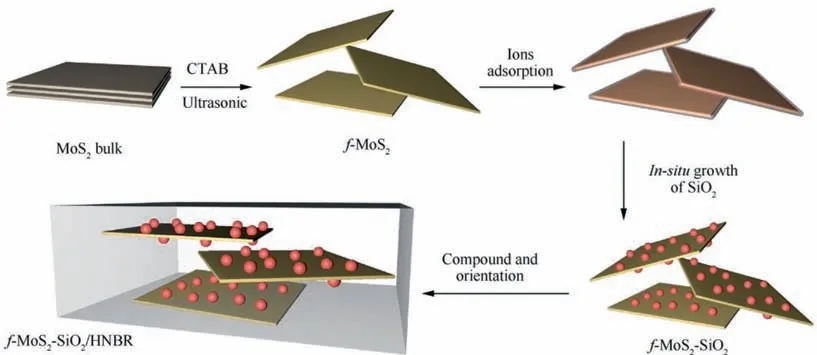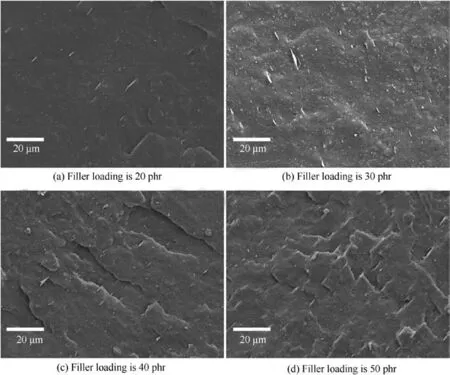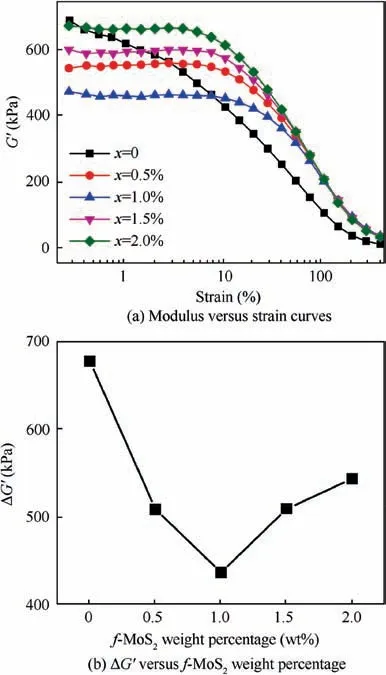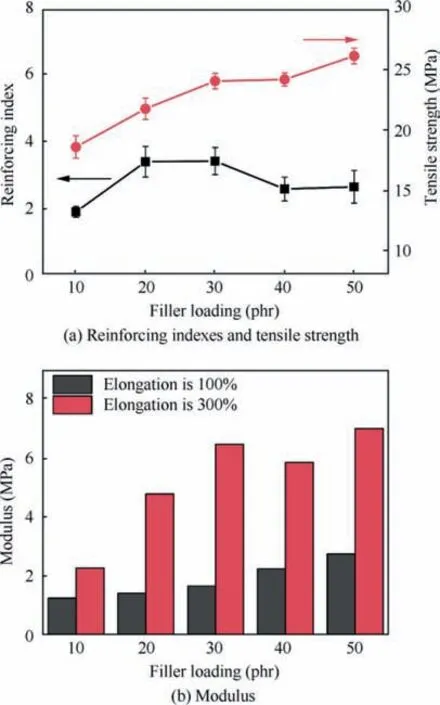Oriented molybdenum disulfide-silica/hydrogenated nitrile butadiene rubber composites: Effects of nanosheets on mechanical and dielectric properties
2023-02-09YnnWANGJunyingSUODongyeWANGLiWEIPingnHOUJinfengPANHongZHU
Ynn WANG, Junying SUO, Dongye WANG, Li WEI, Pingn HOU,Jinfeng PAN, Hong ZHU
a AVIC Chengdu Aircraft Industrial (Group) Co., Ltd, Chengdu 610073, China
b State Key Laboratory of Chemical Resource Engineering,College of Chemistry,Beijing University of Chemical Technology,Beijing 100029, China
KEYWORDS Manufacture;Molybdenum disulfide;Nanocomposites;Orientation;Reinforcement
Abstract A series of non-covalently functionalized molybdenum disulfide-silica (f-MoS2-SiO2)nanocomposites was prepared by an in-situ assembled method and used to fabricate the oriented molybdenum disulfide-SiO2/Hydrogenated Nitrile Butadiene Rubber (f-MoS2-SiO2/HNBR) composites. The characterization results show the synergistic dispersion between the functionalized molybdenum disulfide (f-MoS2) nanosheets and SiO2 nanoparticles. The addition of f-MoS2 nanosheets can improve the dispersion of fillers in the rubber matrix and weaken the filler network.The non-covalently functionalization improves the interface interaction between f-MoS2 nanosheets and the rubber matrix. Furthermore, the tensile strength of f-MoS2-SiO2/HNBR is 65.9% higher than that of SiO2/HNBR by adding 1.0wt% of f-MoS2. At the same time, the dielectric constant of f-MoS2-SiO2/HNBR is increased by 23.7% compared to SiO2/HNBR due to the microcapacitor structure of parallel f-MoS2 nanosheets in the rubber matrix. Our work provides new ideas for the development of high-performance elastomer materials.
1. Introduction
The Hydrogenated Nitrile Butadiene Rubber (HNBR), which processes excellent thermal stability and chemical resistance,is widely used in aviation fields.1,2Poor mechanical properties of neat HNBR are the major obstacle to its practical uses,and the reinforcement of HNBR thus becoming crucial to the applications of HNBR composites. In recent years, silica (SiO2)nanoparticles are used as a potential candidate for rubber reinforcement due to their environmental-friendly and low-cost characteristic, while the rubber composites require high SiO2weight loading (usually above 70 phr (phr means parts per 100 parts rubber by weight).3-5The overloading of SiO2leads to inferior dispersion in the rubber matrix and weak interfacial interaction between SiO2and rubber chains.6
Introducing heterogeneous nanofillers into SiO2reinforce system may be expected to overcome the above limitations,such as One-Dimensional (1D) carbon nanotubes, carbon nanofibers,Two-Dimensional(2D)graphene nanosheets,Layered Double Hydroxide (LDH), boron nitride nanoplatelets,and MoS2nanosheets.7-11A small addition of heterogeneous nanofillers to substitute particle-structured nanofillers substantially improves the advantageous properties of rubber composites.12,13In addition, the combination of functional heterogeneous nanofillers and SiO2can not only introduce functional properties into the rubber matrix but also generate a synergetic effect in improving the performance of rubber composites.14,15Among the reported heterogeneous nanofillers, 2D nanofillers act as the barrier to efficiently restrict the self-aggregation of SiO2nanoparticles, but the strong van der Waals force between the interlayers of 2D materials makes them easy to stack in the rubber matrix. To solve the above problem, the strategies of hierarchical-structured 0D/2D nanocomposites have thus been developed to replace the simple mixture of two kinds of nanofillers.16In the past decades,many efforts have been dedicated to develop SiO2-based nanocomposites as efficient hybrid reinforcements,and considerable progress has been achieved in rubber reinforcing area.17However, it is still far from satisfaction to achieve the goal.
MoS2nanosheets,as typical 2D nanomaterials,have drawn huge attention as promising nanofillers in recent years. MoS2nanosheets have a large aspect ratio and high tensile modulus,leading to the high reinforcing ability for rubber composites.18,19Furthermore,the gaseous impermeability and thermal endurance of MoS2nanosheets make them widely used in flame-retardant elastomer applications.20-22Many publications have reported that MoS2nanosheets can be used as multifunctional nanofillers for advanced composites.23-25However, the application of MoS2nanosheet-based hybrid reinforcements in the HNBR has rarely used been reported.
Surface modification, including covalent and non-covalent modification, is an effective way to improve the dispersion of MoS2nanosheets in rubber matrix.The noncovalent modification is less complicated in preparation process compared to the covalent modification. Furthermore, the noncovalent modification is a mild method than covalent one, and the noncovalent modification can better retain the inherent properties of the MoS2nanosheets. Herein, a series of non-covalent modified molybdenum disulfide-SiO2nanocomposites (f-MoS2-SiO2) were fabricated to reinforce HNBR composites. This work designs a novel nanofiller and proposes a creative strategy in preparing rubber composites for excellent performances.
2. Materials and methods
2.1. Materials
MoS2powder, Hexadecyl Trimethyl Ammonium Bromide(CTAB), sodium silicate, and citric acid were provided by Sigma-Aldrich. Ethanol and H2SO4were bought from Beijing Chemical Works.Zinc oxide,stearic acid antioxidant naugard 445,triallyl isocyanurate,and dicumyl peroxide were industrial products. HNBR (ZP 2010L) was produced by Nippon Zeon Co., Ltd.
2.2. Preparation of f-MoS2-SiO2 nanocomposites
1.5 g MoS2powder was added into 150 mL CTAB solution(1 mol/L). Then, the MoS2was ultrasonic stripped for 6 h.After that, the mixture was further stirred under 30°C for 3 h, and the f-MoS2dispersion was obtained.
The in-situ growth of SiO2nanoparticles was referred our previous work.2640 g sodium silicate was added into above f-MoS2dispersion under stirring, and the mixture was heated at 85°C.After that,5 mL ethanol and 100 mL citric acid solution (150 g/L) was dripped into the above mixture. Then,H2SO4solution (2.5 mol/L) was used to adjust the pH to 5 and the precipitate could be observed. After 10 h, the precipitate was washed by water and ethanol for three times.The precipitate was dried in an oven at 60°C for 10 h and the gray powder was obtained, denoted as f-MoS2-SiO2. A series of f-MoS2-SiO2nanocomposites were prepared by controlling the weight of MoS2from 0.5wt%to 2.0wt%and were denoted as 0.5%-MoS2-SiO2, 1.0%-MoS2-SiO2, 1.5%-MoS2-SiO2, and 2.0%-MoS2-SiO2, respectively.
2.3. Preparation of f-MoS2-SiO2/HNBR composites
The f-MoS2-SiO2/HNBR composites were prepared by a mechanical mixing method. The ingredients and loadings of f-MoS2-SiO2/HNBR composites was displayed in Table 1.The temperature of two roll mills was controlled below 50°C. The distance between the two rollers was controlled below 1 mm. The ingredients and loadings of f-MoS2-SiO2/HNBR composites were listed in Table 1. HNBR was were mixed with ingredients in turn and the f-MoS2-SiO2/HNBR compounds were obtained. Then, the f-MoS2-SiO2/HNBR compounds were cured by a plate vulcanizer under 170°C and a pressure of 15 MPa for 8 min.The f-MoS2-SiO2/HNBR composites were obtained. The dimensions of the composites are the same. The schematic diagram of the manufacturing procedures was shown in Fig. 1.
2.4. Characterization methods
The Fourier Transform Infrared Spectroscopy(FTIR,Bruker)was used to characterize the chemical structure of samples.The elements of the samples were tested by X-ray Photoelectron(XPS,ESCALAB).The microstructure of the nanocomposites and rubber was investigated by Transmission ElectronMicroscope (TEM, Hitachi HT7700) and Scanning Electron Microscope (SEM, JSM-7800), respectively. The viscoelastic performance of rubber compounds was tested by a Rubber Process Analyzer (RPA, Alpa) under 1 Hz and 60°C. The static mechanical properties were tested by tesion machine(SANS CMT4203). The dynamic mechanical properties were tested by a Dynamic Mechanical Analyzer (DMA, Metravib VA3000) under 10 Hz,and the temperature is controlled from-60°C to 60°C with the heat rate of 3°C·min-1. The dielectric constants of rubber samples were tested by an impedance analyzer(Novocontrol Concept 80)from 0.01 Hz to 100 MHz.

Table 1 Ingredients and loadings of f-MoS2-SiO2/HNBR composites.

Fig. 1 Fabrication of f-MoS2-SiO2 composites.
3. Results and discussion
3.1. Characterization of f-MoS2 nanocomposites
The functionalization of f-MoS2and the chemical structure of f-MoS2-SiO2nanocomposites were verified by FTIR. Fig. 2 shows the comparison of the FTIR absorption bands of pristine MoS2,f-MoS2,f-MoS2-SiO2and SiO2.Compared with the spectra of pristine MoS2, two adsorption bands at 2915 cm-1and 2845 cm-1emerge in both spectra of f-MoS2and f-MoS2-SiO2, which are attributed to the C-H stretching vibrations of the modifier.27The broad adsorption band of f-MoS2-SiO2and SiO2at 3500 cm-1is attributed to the -O-H groups of SiO2.16Moreover, the absorption bands of f-MoS2-SiO2at 1700 cm-1are metal-OH.3Furthermore, two strong adsorption bands of f-MoS2-SiO2at 1099 cm-1and 799 cm-1correspond with the stretching vibration of Si-OSi groups, and the band at 490 cm-1corresponds with the bending vibration of O-Si-O of SiO2, confirming the fabrication of f-MoS2-SiO2hybrid.

Fig. 2 FTIR absorption spectra of pristine MoS2, f-MoS2,f-MoS2-SiO2 and SiO2.
XPS was used to further verify the interaction between the f-MoS2nanosheets and SiO2nanoparticles. Fig. 3 shows the Mo 3d and S 2p XPS spectra of f-MoS2and f-MoS2-SiO2.The detailed binding energies of each element are listed in Table 2. The spectra exhibit significant shifts after the formation of f-MoS2-SiO2nanocomposites. The Mo 3d3/2, Mo 3d5/2, S 2p1/2and S 2p3/2of f-MoS2-SiO2all show shifts of -0.3 eV compared with that of f-MoS2, indicating strong interactions between the f-MoS2nanosheets and SiO2nanoparticles.28-31
The microstructure of exfoliated f-MoS2and as-synthesized f-MoS2-SiO2nanocomposites were characterized by TEM. As shown in Fig.4(a),the f-MoS2exhibits a nanosheets structure.Fig. 4(b) and (c) show the SiO2nanoparticles of f-MoS2-SiO2are highly dispersed on the surface of f-MoS2nanosheets due to the functionalization of MoS2nanosheets reduces the agglomeration of the nanoparticles during the in-situ growth process. Furthermore, the diameter distribution of SiO2nanoparticles is shown in Fig. 4(d), and the average diameter of SiO2nanoparticles of f-MoS2-SiO2nanocomposites is 11 nm. As a result, the highly dispersed SiO2nanoparticles on MoS2nanosheets are favorable for improving the filler dispersion in rubber matrix, which is beneficial to the weak filler network of f-MoS2-SiO2/HNBR composites.
3.2. Characterization of f-MoS2-SiO2 nanocomposites
3.2.1. Effects of f-MoS2nanosheets on microstructure of f-MoS2-SiO2/HNBR composites

Fig. 3 XPS spectra of f-MoS2 and MoS2-SiO2.

Table 2 Binding energies of Mo 3d and S 2p.
SEM measurement was used to investigate the microstructure of composites. Fig. 5 shows the SEM photographs of fractured-surface of f-MoS2-SiO2/HNBR and SiO2/HNBR with the same filler loading (30 phr). As shown in Fig. 5(a),(c), and (e), SiO2clusters can be clearly observed in SiO2/HNBR composites, and holes can be seen among the SiO2clusters. Above phenomena can be attributed to the weak interaction between the hydrophilic surface of SiO2and the hydrophobic rubber chains. Fig. 5(b) and (d) exhibit the 2D f-MoS2nanosheets in the rubber matrix and the hierarchical structure of f-MoS2-SiO2nanocomposites. Moreover, Fig. 5(f)shows that SiO2nanoparticles in f-MoS2-SiO2/HNBR exhibit a better dispersion than those in SiO2/HNBR,which can be attributed to the f-MoS2nanosheets act as barriers to prevent SiO2forming aggregation. At the same time, Fig. 5(d) and (f)show that f-MoS2-SiO2was wrapped by the rubber chains and embedded in the rubber matrix, indicating strong filler-rubber compatibility caused by the functionalization of f-MoS2-SiO2. Above characterization of f-MoS2-SiO2/HNBR composites illustrates that hierarchical-structured f-MoS2-SiO2nanocomposites improve the filler dispersion in rubber matrix and strengthen the filler-rubber interaction, suggesting enhanced mechanical properties of f-MoS2-SiO2/HNBR nanocomposites.

Fig. 4 TEM images of f-MoS2, 1.0%-MoS2-SiO2 and diameter distribution of SiO2.

Fig. 5 Microstructure of SiO2/HNBR and 1.0%-MoS2-SiO2/HNBR (filler loading is 30 phr).
Microstructure of 1.0%-MoS2-SiO2/HNBR composites with various filler loadings was further investigated. The filler loadings are 20, 30, 40, 50 phr. As shown in Fig. 6, the orientation of the f-MoS2nanosheets can be observed in four samples.Furthermore,as the filler loadings increase from 20 phr to 50 phr, the orientation phenomenon of f-MoS2nanosheets became more significant, and the roughness of fracturedsurface of f-MoS2-SiO2/HNBR composites are gradually increased. When the filler loading is higher than 40 phr, the oriented f-MoS2nanosheets in the f-MoS2-SiO2/HNBR form a parallel structure.
3.2.2.Effects of f-MoS2nanosheets on filler network of f-MoS2-SiO2/HNBR composites
Effects of f-MoS2nanosheets on the filler network were further evaluated by analyzing the viscoelastic performance of f-MoS2-SiO2/HNBR compounds. Fig. 7 shows the elastic modulus(G')of f-MoS2-SiO2/HNBR compounds with various weight percentages of f-MoS2, where x denotes to the f-MoS2weight percentage. Typically, the difference between the maximum and the minimum of G'(denoted as ΔG')is used to evaluate the ‘‘Payne effect” of the compounds, and the lower ΔG value means the weaker Payne effect and thus indicates to the weaker filler network.32-34All the f-MoS2-SiO2/HNBR compounds show a lower ΔG'than SiO2/HNBR compounds,indicating the addition of 2D MoS2nanosheets can suppress the filler network. Furthermore, ΔG'of f-MoS2-SiO2/HNBR compounds decreases with MoS2weight percentage increasing on the initial stage, to the minimal ΔG'at 1.0wt%, and then increases.This phenomenon can be explained by the evolution of filler network, small amount of MoS2nanosheets can restrain the SiO2to be aggregate and weak the filler network.35However, excess MoS2leads to a more developed filler network due to the inhomogeneous dispersion and the ineluctable stack of 2D MoS2nanosheets.Thus,the above results indicate that the addition of the optimal MoS2nanosheets is beneficial to a weak filler network, which are preconditions to study the influence of the MoS2on the overall properties of rubber composites.

Fig. 6 SEM photographs of freeze-fractured surfaces of f-MoS2-SiO2/HNBR with various filler loadings.

Fig.7 Modulus versus strain curves of SiO2/HNBR compounds and f-MoS2-SiO2/HNBR compounds, and ΔG' versus f-MoS2 weight percentages (filler loading is 30 phr).
3.3. Mechanical performance of f-MoS2-SiO2/HNBR composites
3.3.1. Effects of f-MoS2nanosheets on static mechanical performance
The static mechanical performance of f-MoS2-SiO2/HNBR composites with different f-MoS2weight percentages and f-MoS2-SiO2filler loadings are shown in Figs.8 and 9,respectively. Reinforcing Index (RI) is considered as an important parameter to evaluate the reinforcing efficiency of the filler in rubber composites.26,36As shown in Fig.8,the RI and modulus of the f-MoS2-SiO2/HNBR increase as the f-MoS2weight percentage increases from 0 (SiO2/HNBR) to 1.0 wt%,because the incorporation of a small amount of f-MoS2can breakdown the SiO2aggregate and improve filler dispersion,and thus weaken the filler network of f-MoS2-SiO2/HNBR.Furthermore, the weakened filler network decreases the amounts of the entrapped rubber chain by the filler agglomeration and thus reduces the amounts of stress-concentrated regions in 1.0%-MoS2-SiO2/HNBR composites. However,the RI of f-MoS2-SiO2/HNBR decreases as the f-MoS2weight percentage increase from 1.0 wt% to 2.0 wt%. This phenomenon can be explained by the formation of a more developed filler network in f-MoS2-SiO2/HNBR composites that can decrease the effective filler volume, which is caused by the stack of excess f-MoS2nanosheets.37Meanwhile, the RI and tensile strength of all the f-MoS2-SiO2/HNBR composites are higher than those of SiO2/HNBR. Notably,the RI and tensile strength of 1.0%-MoS2-SiO2/HNBR is 229.4% and 65.9%higher than those of SiO2/HNBR,respectively, indicating that f-MoS2nanosheets play a role to improve the reinforcing efficiency of f-MoS2-SiO2nanocomposites in HNBR.

Fig. 8 Static mechanical performance of f-MoS2-SiO2/HNBR composites with different f-MoS2 weight percentages(filler loading is 30 phr).
3.3.2. Effects of f-MoS2-SiO2nanocomposites on static mechanical performanceconcentrated regions in f-MoS2-SiO2/HNBR composites and reduce the reinforcing efficiency of f-MoS2-SiO2.38The mechanical properties of HNBR composites reinforced by various fillers are listed in Table 3,10,26,39-49including 1.0%-MoS2-SiO2nanocomposites prepared in this work and other fillers reported in the literature. It is worth mentioning that the reinforcement abilities of 1.0%-MoS2-SiO2is better than that of other fillers especially in terms of the tensile strength.

Fig. 9 Static mechanical performance of 1.0%-MoS2-SiO2/HNBR with different filler loadings.
3.3.3. Effects of f-MoS2nanosheets on dynamic mechanical performance
In order to clarify the effects of f-MoS2nanosheets on the dynamic mechanical performance of f-MoS2-SiO2/HNBR composites, the relationships between storage modulus (E')and temperature were studied. As shown in Fig. 10(a), the E'of all the samples decreases as the temperature increases,which is attributed to the energy dissipation due to the motion of rubber chains from glassy to rubber state. Furthermore, in glassy region, the E'of f-MoS2-SiO2/HNBR composites increases as the f-MoS2weight percentage increases, reaching a maximum at 1.0wt% of f-MoS2, and then decrease. This phenomenon can be explained by the motion of rubber chains. The motion of rubber chains is restricted by the low temperature and the filler network plays a key role on the E'of the f-MoS2-SiO2/HNBR composites. When the f-MoS2weight percentage is higher than 1.0wt%, the filler network is strengthened and the composites shows a lower value of E'. Fig. 10(b) shows the loss factor (tan δ)-temperature curves of f-MoS2-SiO2/HNBR and SiO2/HNBR composites.The results show that the f-MoS2-SiO2/HNBR composites exhibit higher peak value of tan δ than SiO2/HNBR composites, indicating the interfacial interaction between f-MoS2nanosheets and rubber chains leads to an increase in the friction.

Table 3 Comparison of tensile strength and elongation at break of MoS2-SiO2/HNBR and various HNBR composites reported in literature.10,26,39-49
3.4. Dielectric properties of f-MoS2-SiO2/HNBR composites
Fig. 11 shows the dielectric properties of SiO2/HNBR and 1.0%-MoS2-SiO2/HNBR composites with various filler loadings (20, 30, 40, 50 phr), and the filler loading of SiO2/HNBR is 40 phr.Under the same filler loading of 40 phr,the dielectric constant of 1.0%-MoS2-SiO2/HNBR is increased by 23.7%compared to that of SiO2/HNBR at 103Hz.It is reported that the dielectric properties of rubber composites are mainly affected by the micro-capacitor structure and the interface polarization of fillers.50The micro-capacitor mechanism is that two fillers arranged in parallel and polymer matrix between the two can form a micro-capacitor. Each micro-capacitor can contribute to the increase in the capacitance of the composites.Within a certain range,increasing the filler content leads to an increase in the number of micro-capacitors, which is good to obtain a composite material with a higher dielectric constant.From the SEM photographs of fractured-surface of f-MoS2-SiO2/HNBR (Fig. 6), it can be observed that f-MoS2nanosheets are arranged in parallel, which increases the micro-capacitor structure, and thus improves the dielectric constant of rubber composites. Furthermore, the accumulation of polarized charges at filler-rubber interface also leads to an increase in dielectric constants according to the Maxwell-Wagner-Sillars effect.48,50The filler-rubber interfacial interaction of f-MoS2-SiO2/HNBR is higher than that of SiO2/HNBR, leading to a stronger interfacial polarization and a higher dielectric constant.

Fig. 10 Dynamic mechanical performance of f-MoS2-SiO2/HNBR composites (filler loading is 30 phr).

Fig. 11 Dielectric properties of SiO2/HNBR and 1.0%-MoS2-SiO2/HNBR composites with various filler loadings.
4. Conclusions
(1) A series of hierarchical-structured f-MoS2-SiO2were fabricated to reinforce HNBR composites in this paper,and the oriented f-MoS2-SiO2/HNBR composites were obtained by a sample mechanical mixing method.
(2) The microstructure of f-MoS2, f-MoS2-SiO2, and f-MoS2-SiO2/HNBR composites were investigated. The 2D f-MoS2nanosheets act as a barrier to prevent SiO2forming aggregation and improve the dispersion of fillers in the rubber matrix. The f-MoS2nanosheets can efficiently weaken the filler network and strength the filler-rubber compatibility.
(3) The effects of f-MoS2nanosheets on the mechanical performance and dielectric properties of f-MoS2-SiO2/HNBR composites were studied. The RI, tensile strength, and dielectric constant of 1.0%-MoS2-SiO2/HNBR are 229.4%, 65.9%, and 23.7% higher than those of SiO2/HNBR, respectively. Those results demonstrate the advantages of f-MoS2nanosheets, and the oriented f-MoS2-SiO2/HNBR composites have the potential to develop of high-performance elastomer materials for aviation applications.
Declaration of Competing Interest
The authors declare that they have no known competing financial interests or personal relationships that could have appeared to influence the work reported in this paper.
Acknowledgement
This work was supported by the National Basic Research Program of China (No. 2015CB654703).
杂志排行
CHINESE JOURNAL OF AERONAUTICS的其它文章
- Recent developments in thermal characteristics of surface dielectric barrier discharge plasma actuators driven by sinusoidal high-voltage power
- A review of bird-like flapping wing with high aspect ratio
- Rotating machinery fault detection and diagnosis based on deep domain adaptation: A survey
- Stall flutter prediction based on multi-layer GRU neural network
- Supervised learning with probability interpretation in airfoil transition judgment
- Effects of input method and display mode of situation map on early warning aircraft reconnaissance task performance with different information complexities
